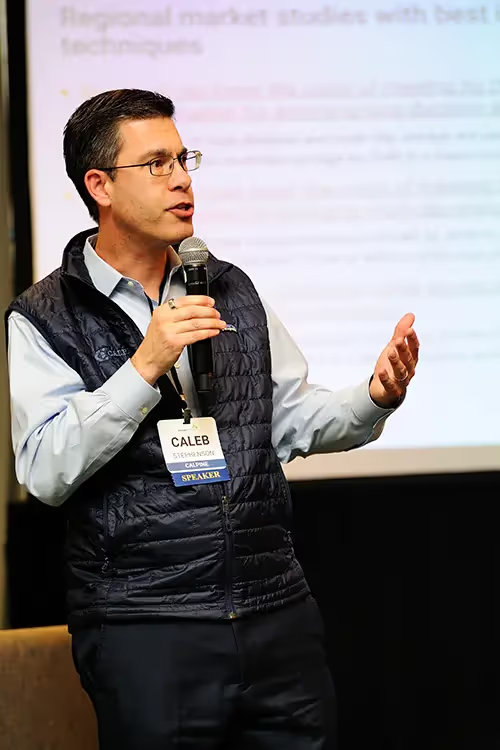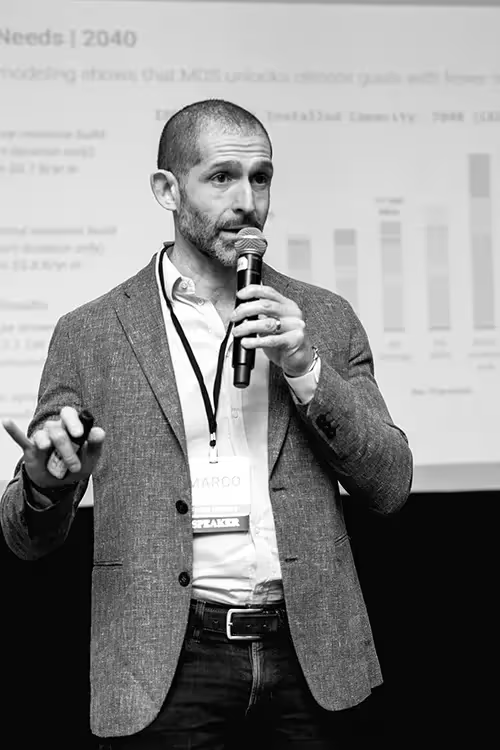
Let's Connect
Contact us
Thank you for reaching out, we will be in touch shortly!
Oops! Something went wrong while submitting the form.


Carbon Capture and Storage (CCS) technology and extended-duration storage look more promising than ever. These technologies have the maturity, scalability, and cost-effectiveness needed to make a substantial impact on reducing carbon emissions and enhancing the reliability of renewable energy grids. However, concerns still exist in terms of integrating these technologies to mitigate the negative effects of intermittency and overbuild, as well as ensuring reliability and cost effectiveness. At the Ascend Summit 2023, Dr. Rodney Kizito, Senior Manager of Energy Analytic Services at Ascend Analytics, moderated a panel that addressed these topics. Panelists included Caleb Stephenson, EVP of Commercial Operations at Calpine, as well as Dr. Marco Ferrara, Co-Founder and SVP Software and Analytics at Form Energy.

Mr. Stephenson explained how Carbon Capture and Storage (CCS) technology involves capturing carbon dioxide emissions from power plants and industrial processes, then safely storing them underground. This approach prevents emissions from entering the atmosphere and contributing to climate change. CCS can serve as a critical tool in the fight against carbon emissions, as well as help to make significant progress toward a more environmentally sustainable future.
The state of CCS technology looks more promising than ever, with various well-established components and processes. For example, amine capture columns with metal lattice packing inside have been used for decades in various applications, including the capture of sulfur dioxide (SO2) and other acid gases. These components have stood the test of time, providing reliability and efficiency in gas-capture processes.
While the scale of CCS for natural gas generation facilities does push the technology to its limits, it doesn't require completely novel breakthroughs. The technology can handle the challenge of processing a substantial amount of flue gas, and it does so within the framework of tried-and-true equipment and processes. This ability to operate within existing infrastructure means that CCS technology requires no complex interconnects or transformers, enabling a rapid and efficient carbon reduction process, which provides a crucial advantage in the race to combat climate change.
Moreover, simplifying the interconnect between a CCS plant and a power generation facility can eliminate complexities. The design focuses on streamlining this interaction, which contributes to the overall feasibility and success of the project.
In a particularly encouraging development, insurance companies and financing organizations are starting to back CCS initiatives, thus providing crucial financial support for moving forward with large-scale CCS projects, as well as signaling a growing confidence in the technology's feasibility and effectiveness.
One of the most exciting aspects of CCS technology involves its potential to significantly reduce carbon emissions. Retrofitting existing facilities with CCS technology offers a remarkable solution for carbon reduction in the industrial sector, especially for those organizations that seek to achieve near-zero carbon emissions.
More exciting: CCS technology can be applied to multiple facilities across the country. According to Ascend Summit panelists, one particularly ambitious goal involves leveraging cogen technology not only in the power sector but also in the industrial sector. This versatility sets CCS apart from many other technologies and positions it as a valuable tool in the broader effort to reduce carbon emissions.
Panelists also noted a rapidly evolving energy landscape, in which companies lead the way in developing innovative solutions to address the challenges of renewable energy generation, particularly extended intermittency. Renewables, such as solar and wind, have well-known diurnal intermittency, with daily variations in energy generation. However, addressing multi-day intermittency, especially during extreme weather events, remains a significant challenge.

Dr. Ferrara presented a unique approach to addressing this issue with extended-duration energy storage. Form Energy has developed a technology that utilizes the rusting and half-rusting of iron as a cost-effective and scalable solution for multi-day energy storage. With the right infrastructure, this safe and abundant material can be harnessed to provide reliable energy storage for extended periods.
The use of this technology offers profound implications. It has the potential to reshape approaches to renewable energy integration and grid reliability. By storing excess renewable energy during low-demand periods and releasing it during peak demand or during extended renewable lulls, this technology can help balance the grid and ensure a stable energy supply.
According to panelists, integrated resource planning will continue to serve as a key aspect of the transition to deeply renewable grids. The methodology presented during the panel considered the full resolution of weather patterns, load variations, and resource availability across multiple years, thus enabling a more accurate assessment of the economics and reliability of future grid portfolios.
Introducing long-duration and multi-day storage solutions can significantly reduce the need for overbuilding renewable resources and can minimize curtailment. This not only improves the economics of renewable energy integration but also enhances grid reliability, even during extreme weather conditions.
Ultimately, Ascend Summit panelists agreed that the potential of CCS technology and extended-duration energy storage solutions appears incredibly promising. These technologies possess the maturity, scalability, and cost-effectiveness needed to make a substantial impact on reducing carbon emissions and enhancing the reliability of renewable energy grids. Moving forward, these innovations will play a crucial role in the transition to a more sustainable and resilient energy future.

Carbon Capture and Storage (CCS) technology and extended-duration storage look more promising than ever. These technologies have the maturity, scalability, and cost-effectiveness needed to make a substantial impact on reducing carbon emissions and enhancing the reliability of renewable energy grids. However, concerns still exist in terms of integrating these technologies to mitigate the negative effects of intermittency and overbuild, as well as ensuring reliability and cost effectiveness. At the Ascend Summit 2023, Dr. Rodney Kizito, Senior Manager of Energy Analytic Services at Ascend Analytics, moderated a panel that addressed these topics. Panelists included Caleb Stephenson, EVP of Commercial Operations at Calpine, as well as Dr. Marco Ferrara, Co-Founder and SVP Software and Analytics at Form Energy.

Mr. Stephenson explained how Carbon Capture and Storage (CCS) technology involves capturing carbon dioxide emissions from power plants and industrial processes, then safely storing them underground. This approach prevents emissions from entering the atmosphere and contributing to climate change. CCS can serve as a critical tool in the fight against carbon emissions, as well as help to make significant progress toward a more environmentally sustainable future.
The state of CCS technology looks more promising than ever, with various well-established components and processes. For example, amine capture columns with metal lattice packing inside have been used for decades in various applications, including the capture of sulfur dioxide (SO2) and other acid gases. These components have stood the test of time, providing reliability and efficiency in gas-capture processes.
While the scale of CCS for natural gas generation facilities does push the technology to its limits, it doesn't require completely novel breakthroughs. The technology can handle the challenge of processing a substantial amount of flue gas, and it does so within the framework of tried-and-true equipment and processes. This ability to operate within existing infrastructure means that CCS technology requires no complex interconnects or transformers, enabling a rapid and efficient carbon reduction process, which provides a crucial advantage in the race to combat climate change.
Moreover, simplifying the interconnect between a CCS plant and a power generation facility can eliminate complexities. The design focuses on streamlining this interaction, which contributes to the overall feasibility and success of the project.
In a particularly encouraging development, insurance companies and financing organizations are starting to back CCS initiatives, thus providing crucial financial support for moving forward with large-scale CCS projects, as well as signaling a growing confidence in the technology's feasibility and effectiveness.
One of the most exciting aspects of CCS technology involves its potential to significantly reduce carbon emissions. Retrofitting existing facilities with CCS technology offers a remarkable solution for carbon reduction in the industrial sector, especially for those organizations that seek to achieve near-zero carbon emissions.
More exciting: CCS technology can be applied to multiple facilities across the country. According to Ascend Summit panelists, one particularly ambitious goal involves leveraging cogen technology not only in the power sector but also in the industrial sector. This versatility sets CCS apart from many other technologies and positions it as a valuable tool in the broader effort to reduce carbon emissions.
Panelists also noted a rapidly evolving energy landscape, in which companies lead the way in developing innovative solutions to address the challenges of renewable energy generation, particularly extended intermittency. Renewables, such as solar and wind, have well-known diurnal intermittency, with daily variations in energy generation. However, addressing multi-day intermittency, especially during extreme weather events, remains a significant challenge.

Dr. Ferrara presented a unique approach to addressing this issue with extended-duration energy storage. Form Energy has developed a technology that utilizes the rusting and half-rusting of iron as a cost-effective and scalable solution for multi-day energy storage. With the right infrastructure, this safe and abundant material can be harnessed to provide reliable energy storage for extended periods.
The use of this technology offers profound implications. It has the potential to reshape approaches to renewable energy integration and grid reliability. By storing excess renewable energy during low-demand periods and releasing it during peak demand or during extended renewable lulls, this technology can help balance the grid and ensure a stable energy supply.
According to panelists, integrated resource planning will continue to serve as a key aspect of the transition to deeply renewable grids. The methodology presented during the panel considered the full resolution of weather patterns, load variations, and resource availability across multiple years, thus enabling a more accurate assessment of the economics and reliability of future grid portfolios.
Introducing long-duration and multi-day storage solutions can significantly reduce the need for overbuilding renewable resources and can minimize curtailment. This not only improves the economics of renewable energy integration but also enhances grid reliability, even during extreme weather conditions.
Ultimately, Ascend Summit panelists agreed that the potential of CCS technology and extended-duration energy storage solutions appears incredibly promising. These technologies possess the maturity, scalability, and cost-effectiveness needed to make a substantial impact on reducing carbon emissions and enhancing the reliability of renewable energy grids. Moving forward, these innovations will play a crucial role in the transition to a more sustainable and resilient energy future.
Ascend Analytics is the leading provider of market intelligence and analytics solutions for the power industry.
The company’s offerings enable decision makers in power development and supply procurement to maximize the value of planning, operating, and managing risk for renewable, storage, and other assets. From real-time to 30-year horizons, their forecasts and insights are at the foundation of over $50 billion in project financing assessments.
Ascend provides energy market stakeholders with the clarity and confidence to successfully navigate the rapidly shifting energy landscape.